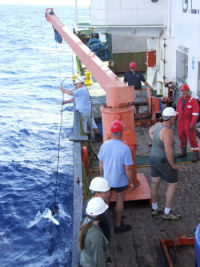COMPAS (Characteristics of Organic Microlayer Produced AerosolS)
Introduction
The surface of the ocean is closely coupled to the radiative properties of clouds through the generation of sea spray aerosol particles that range from 100 nm to several um in diameter and which subsequently act as sites for cloud droplet formation. The number of cloud droplets is highly dependent on the number, size and composition of particles entering the cloud. The size and composition determine the surface tension and chemical activity of the drops, key parameters in determining whether an aerosol particle will form a cloud droplet or not. The cloud droplet number concentration in turn controls the radiative properties of the cloud, the greater the droplet number, the more reflective the cloud. This can change the amount of radiation reaching the surface and impact on regional and global surface temperatures. The links described are very poorly quantified and provide the most uncertain forcings of climate that are currently assessed by the Intergovernmental Panel on Climate Change (IPCC).
The ocean surface is rich in organic material resulting from micro-organisms that are present in the surface waters. Biological detritus is significantly hydrophobic and, like oil, partitions to the surface forming a film. Such organic surface films have been known about for some time and may be responsible for changing air-sea exchange rates of gaseous material and also altering the surface tension of the sea. Most relevant to this proposal is that particles containing organic material may be produced by the action of wind driven white caps breaking on the ocean surface. Previously, cloud modellers have considered sea spray derived particles to be composed of inorganic salts similar to bulk seawater, predominately sodium chloride. However, recent work published in Nature has shown that the particles in the accumulation mode (between 100 nm and 1 um in size) which dominate the particle number in the marine atmosphere are very rich in organic material from the SSML.
Organic species have very different surface tensions and chemical activities which is why they partition to the surface of the ocean in the first place, hence it is to be expected that the formed particles will have very different properties from sodium chloride.

This project seeks to harvest the organic material in the SSML, determine the major biological speciation, culture it and biologically synthesise significant quantities of the material. This synthesised product, which will be chemically similar to the organic in the SSML, will be sprayed into a large chamber as an aerosol, either on its own or mixed with sulphate and/or sodium chloride and its impact on particle properties studied using a wide range of state of the art instrumentation to probe its physical and chemical properties, including its ability to form cloud droplets. These data will be used to test a detailed model of the properties of the aerosol particles we have developed at Manchester. Once we have constrained the model using the laboratory generated data, a series of simulations will be conducted to test the likely impact the findings from the laboratory will have on clouds in the marine boundary layer.
There is a clear need to perform this work to reduce the uncertainty in our estimates of cloud droplet number in shallow marine clouds, a particularly radiatively important cloud type. Furthermore, there is a direct link between the surface ocean, clouds and climate. It has been postulated that marine biota are likely to be sensitive to climate change and a change to the biology may significantly impact on the aerosol and hence cloud properties in a highly uncertain way. The sign of such a change remains unknown, and we need to quantify such variability if we are to predict future impacts on climate and linkages between the ocean and climate changes in the future.
Objectives
The objective of this experiment is to elucidate the extent to which the biological material in the Sea Surface MicroLayer (SSML) can affect the properties of atmospheric marine aerosol particles through its impact on their water affinity and cloud nucleating properties. Hence we aim to assess the capacity of aerosol generated from SSML to act as an important climate feedback pathway by changing the optical properties of clouds.
Specifically we will:
- Establish the main species responsible for forming the surfactant layer of the surface ocean as a function of time
of year and latitude in the eastern Atlantic Ocean.
- Assess the impact of organic biological surfactants on sea spray aerosol properties
- Quantify the extent to which the organic material in the SSML can influence cloud droplet number in
stratocumulus clouds.
- Assess the relative contributions to the cloud droplet number population of SSML modified sea spray and
sulphate aerosols in a range of model marine stratocumulus clouds and hence determine the likelihood that this
mechanism may act as an important climate feedback pathway.